papal transition
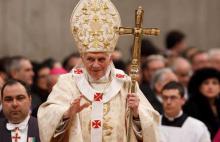
Pope Emeritus Benedict XVI resigned from the papacy because “God told me” to, according to a report by a Catholic news agency.
The Zenit news agency reported on Monday that Benedict decided to step back as a result of what he described as a “mystical experience” that shouldn’t be confused with a vision.
That experience sparked an “absolute desire” to dedicate his life exclusively to prayer, in a solitary relationship with God, Benedict reportedly said.
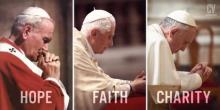
As a millennia-old institution, the Vatican is accustomed to change at a glacial pace. But in the eyes of many outside the church — and even of some within it — the arrival of Pope Francis on the throne of St. Peter seems to have started nothing short of a revolution.
Even Francis himself, in his speech to Rome’s diocese on Monday, said that Christians not only can, but should, be “revolutionaries.”
Now, 100 days into his pontificate, a debate is brewing in Rome over whether Francis has set a distinctly different course from his predecessor, or whether the visible differences in style and personality between Francis and Benedict XVI mask a deeper theological and ideological continuity.
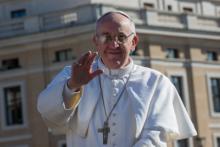
When Pope Benedict XVI shocked the world in February in becoming the first pope to resign in 600 years, he left behind a Roman Catholic Church weakened by scandals, beset by infighting and suffering from a general sense of isolation from the modern world.
Three months after the election of Argentine Cardinal Jorge Bergoglio as Pope Francis, much of the gloom seems to have lifted.
St. Peter’s Square is again a magnet for legions of pilgrims, and the communications problems that dogged Benedict’s papacy have receded. Francis’ simpler, direct style, together with his focus on the poor and the marginalized, has captivated the world.
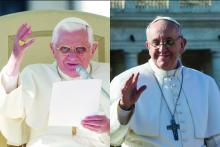
Now that the cardinals have elected and installed their new boss, Pope Francis can get to work being the Roman Catholic pontiff, with his next order of business doing something no other pope has done in centuries: meet the guy he replaced.
Benedict’s resignation — the first by a pope in 600 years — paved the way for the conclave that elected Francis on March 13, but it also created an almost unprecedented potential for confusion and division in a church hierarchy that has room for only one pope at a time.That will happen on Saturday, when Francis is scheduled to travel a few miles outside Rome to the hilltop town of Castel Gandolfo, the summer papal residence where Benedict XVI has been staying — out of sight — since he resigned and left the Vatican on Feb. 28.
“Benedict XVI could turn into a shadow pope who has stepped down but can still exert indirect influence,” said Hans Kung, the dissident Swiss theologian and friend (as well as frequent critic) of Benedict’s since he and the former Joseph Ratzinger were up-and-coming theologians.
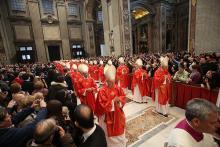
Last Sunday night, the Rev. Thomas Rosica was walking through the Piazza Navona in Rome’s historic center when he bumped into Cardinal Jorge Bergoglio, who he has known for years. Bergoglio was walking alone, wearing a simple black cassock and he stopped and grabbed Rosica’s hands.
He had reason to be worried. Two days later, on Tuesday evening, he and 114 other cardinals entered the conclave to elect a successor to Benedict XVI; a little more than 24 hours and five ballots after that, Bergoglio emerged on the balcony of St. Peter’s Basilica as Pope Francis. “I want you to pray for me,” the Argentine cardinal told Rosica, a Canadian priest who was assisting as a Vatican spokesman during the papal interregnum. Rosica asked him if he was nervous. “A little bit,” Bergoglio confessed.
It was a surprising outcome, and even if Bergoglio suspected something was up, few others did, including many of the cardinals in the Sistine Chapel with him.
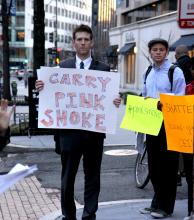
As cardinals in the Vatican wrapped up the first day of the conclave with no decision on the next pope, a small crowd assembled on the steps of the Cathedral of St Matthew the Apostle here in Washington, D.C., with signs, a guitar, and fervent prayers that the conclave would usher in a new openness to women in Catholic leadership.
The chilly March wind rose as volunteers passed around flickering candles. “There’s too much Holy Spirit here tonight,” one organizer joked. “We should tell her to tone it down a bit.”
Those assembled were praying for something popes have long opposed: an active recognition of women as decision-makers in the church.
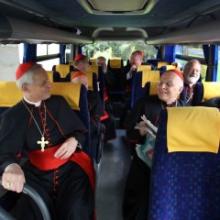
As the Vatican prepares for the opening of the conclave today to elect a new pope, officials announced that the personal secretary of former Pope Benedict XVI will return to Rome for the first time since Benedict’s resignation on Feb. 28.
The Vatican’s chief spokesman, the Rev. Federico Lombardi, confirmed on Monday that Gaenswein will be one of the senior Vatican officials to take part in the solemn procession of cardinals into the Sistine Chapel that will open the conclave on Tuesday afternoon.Archbishop Georg Gaenswein, who was Benedict’s closest aide when he was pope, moved with Benedict to the papal summer residence of Castel Gandolfo when the retired pope left the Vatican on Feb. 28.
His presence will once again highlight the unprecedented situation — and potential complications — of having a retired pope still living just as cardinals gather to elect his successor.
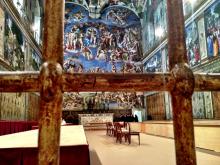
As if the task of choosing the Vicar of Christ and the leader of the world’s 1.2 billion Catholics wasn’t daunting enough, the voting must also take place under the gaze of Michelangelo’s brilliant but imposing frescoes in the Sistine Chapel.
That’s what the late Pope John Paul II decreed when he rewrote the conclave rules in 1996, and so it shall be starting today — and for however many days it takes the 115 cardinal-electors to choose a successor to Pope Emeritus Benedict XVI, who retired last month.
In the Sistine Chapel, “everything is conducive to an awareness of the presence of God, in whose sight each person will one day be judged,” John Paul II wrote in his 1996 Apostolic Constitution “Universi Dominici Gregis,” which regulates papal elections.
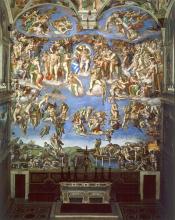
In Catholic theology, as in the popular imagination, the closed-door conclave to elect a new pope is supposed to be guided by the Holy Spirit.
There’s no horse-trading or lobbying, no insider deal-making or outside influences allowed. Just red-robed cardinals solemnly entering the Sistine Chapel, accompanied only by prayers and their consciences, sitting beneath Michelangelo’s fresco of the Last Judgment and discerning God’s will on who should be the next successor to St. Peter.
At least that’s the theory. The last millennium has shown that papal elections can be fraught with politics or worse, and can take months or even years of wrangling to reach a resolution.
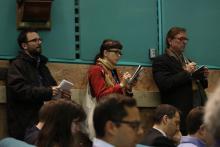
Tensions among the Roman Catholic cardinals meeting here to choose a new pope appeared to escalate on Wednesday as the American prelates in Rome canceled their daily press briefing under pressure from colleagues who are frustrated over news coverage of their secret talks.
The cardinals also announced that they still had not been able to agree on a start date for the conclave, in which 115 electors will cast their ballots for a successor to Pope Benedict XVI.
The effort to control the flow of information from the daily pre-conclave “General Congregation” meetings marked a sharp reversal from the unprecedented openness that had characterized this first papal conclave of the digital age.
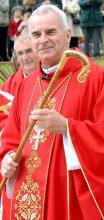
Days after pulling out of the conclave to elect the next pope and vowing to fight the charges against him, disgraced Scottish Cardinal Keith O’Brien admitted Sunday to inappropriate “sexual conduct.”
O’Brien, who until a week ago was the highest-ranking Roman Catholic cleric in England and Scotland, had served as archbishop of St. Andrews and Edinburgh for the last seven years and was made a cardinal in 2003.
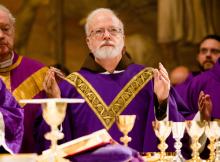
Roman Catholic cardinals on Monday met for the first of a series of closed-door meetings in the run-up to the conclave that will elect the successor to former Pope Benedict XVI.
But as cardinals filed into a Vatican conference room under the gaze of dozens of cameras, church officials said 12 voting prelates still haven’t arrived in Rome, pushing back the possibility of an early start to the conclave.
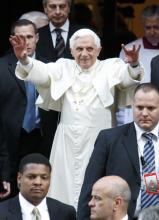
In his final public address, Pope Benedict XVI on Wednesday forcefully defended his decision to resign while trying to reassure Catholics still reeling from the shock of his unprecedented move.
For the first time since his stunning announcement on Feb. 11, the 85-year-old pope explained at length his decision to become the first pope in six centuries to resign. His tenure officially ends Thursday at 8 p.m. local time.
Benedict admitted that his resignation is a “grave” and “novel” act but, he added, his choice had been made “with profound serenity.”
“Loving the church means having the courage to make difficult, agonizing choices, having ever before oneself the good of the church and not one’s own,” he said.
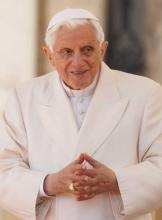
You won’t find many Catholic churches named after Pope Benedict IX.
Benedict IX squandered the papacy’s moral and financial riches in bordellos and banquet halls. His violence and debauchery “shocked even the Romans,” said philosopher Bertrand Russell, which is kind of like being busted for lewdness in Las Vegas. He was a puppet pope, installed by his powerful family at a time when rival clans ruled Rome. The young man seemed uninterested in religious life, rushing through ordination only after his election to the Throne of St. Peter in 1032.
St. Peter Damian called Benedict IX a "demon from hell in the disguise of a priest." The Catholic Encyclopedia labels him a “disgrace to the chair of St. Peter.” He was the first Pope Benedict to resign, selling the papacy for gold in order to marry. He later tried to reclaim the holy office and served three stints as pope between 1032 and 1048.
Nearly a millennium later, the pious and bookish Pope Benedict XVI seems completely contrary to his notorious namesake. Even if his papacy has stumbled at times, by all accounts the current Benedict has led a chaste life devoted to serving his church.
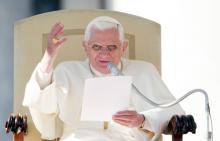
VATICAN CITY — Pope Benedict XVI will be known as “Pope Emeritus” after his retirement on Feb. 28, and will continue to wear white vestments, the Vatican announced on Tuesday.
Ever since Benedict’s surprise announcement that he would become the first pope in 600 years to resign, there had been wide speculation about seemingly small issues, such as what he would be called or whether he would retain the title of “pope.” Such details, however, carry great symbolical value within the tradition-bound Roman Catholic Church.
The Rev. Federico Lombardi, the Vatican’s chief spokesman, told reporters that Benedict will continue to be called “His Holiness” and that his title will be “Pope Emeritus” or “Emeritus Roman Pontiff.”
He said Benedict had decided the issue himself, after consultations with experts.